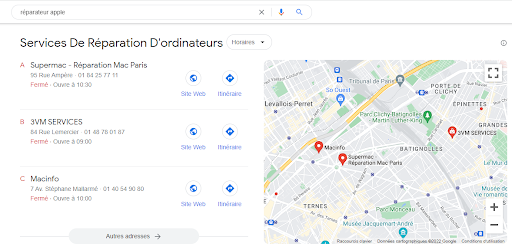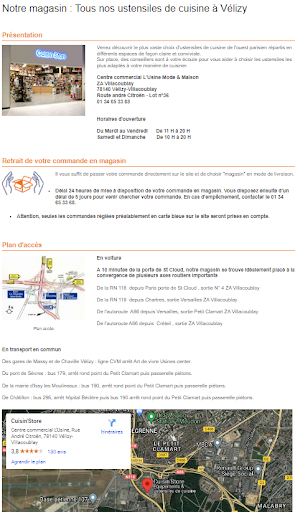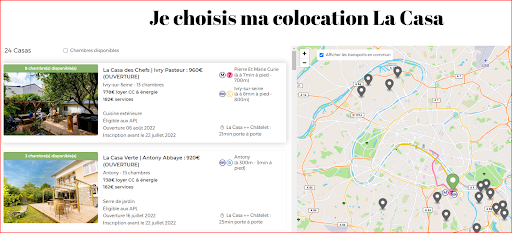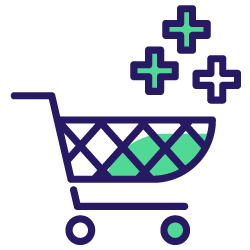What is phygital?
At the end of the 90’s and beginning of the 2000’s, the first e-commerce sites were launched. However, most of the purchases were still made in stores. With the advent of smartphones, marketing strategies have become omni-channel. The objective is to facilitate customer purchases and increase sales by connecting the dots between all points of contact with a customer. This is called phygital marketing.
Phygital is a contraction of physical and digital. This strange word, which appeared in 2013, is a marketing concept that combines a digital presence (a website, a Youtube channel, …) and a physical business or a local activity (hairdresser, plumber, taxi, ..).
What’s the purpose of phygital marketing?
While we can access the Internet from almost anywhere in the world, a physical store is located in one (or more) precise place. Although, a craftsman may be mobile, his catchment area will be limited.
So, the interest of phygital is to increase awareness of the store or its local activity via a digital medium.
And conversely, a store can make its web presence known so that customers, already familiar with the products or services offered, are no longer obliged to go through the store but can place their orders online.
How to make yourself known on the web?
There are many ways to make yourself known on the Internet:
- Natural referencing in search engines
- Paid referencing
- Social networks
- Newsletters
- Directories
- Comparison and affiliation sites
- YouTube channels
But all these solutions lead to competition with national or even global players, whereas the objective of phygital is to be known on a digital and local level. Therefore, there is only one effective solution: local SEO.
What is local SEO?
To be sure that we are talking about the same thing, here we define local SEO as ranking your site in the local Google pack.
What is the Google pack?
In the Google pack, there are the two different types of displays that appear in the Google SERPs:
- Google Maps
- Google business listings or Google My Business (GMB)
When is Google Maps displayed?
Google Maps is displayed when Google detects a user’s intention to search for a physical store related to the initial query.
According to Google: “More than 40% of people go to Google to research the purchase they plan to make online or in-store.”
It is, by the way, not necessary for the query to contain a specific location (e.g. hairdresser Paris). Google is now smart enough to know that behind a query like “Apple repair”, there is an intention to go to a store.

When does the Google My Business page appear?
The Google My Business page appears when Google detects the user’s intention to search for information about a specific store or a brand: opening hours, product inventory, delivery, etc.
Why do local SEO?
Increase the traffic in your store
This is clearly the objective of phygital: to make your business known on the Internet in order to bring users to your store. 70% of Internet users go to a business after clicking on a Google Maps ad.
The Local Pack is highlighted on SERPs
It is highlighted in the right-hand column of the establishment’s page and in the top positions (often before the 1st SEO position in 93% of cases) for Google Maps.
Triggering the Local Pack on a large number of transactional requests
It even triggers those that are not geolocated like “women’s shoes” or “watch repair”.
In these two cases, Google has identified a purchase intention (transactional queries) and it proposes the nearest stores.
Counting the queries where the location is specified, this represents 33% of the requests. Let’s remember, by the way, the importance of being present on transactional queries. A transactional query is the one that generates a purchase.
Before there were:
- Informational queries to find out about the product or service you want to buy.
- Commercial queries to find out about prices (comparison sites), Internet users’ opinions, etc.
- During a transactional query, the user knows what he wants to buy, at what price and often where he will buy it. It is on these queries that Google proposes the Local Pack to offer the user the option to buy via the website or via a trip to the store.
Local SEO is dependent on Google’s algorithms
Google Pigeon
At the end of 2014, Google implemented a new algorithm specialized in local SEO: Pigeon. This algorithm is based on hundreds of criteria. However, the most important criteria would be brand awareness (reviews) and geolocation.
Google Opossum
In 2016, Google released Opossum, an update to the Pigeon algorithm. This update is mainly focused on the relevance of local SEO with three important changes:
- Before, a business in the Paris suburbs with a catchment area in Paris did not appear on a query involving “… Paris”. With Opossum this is now possible.
- The geolocation of the user is taken into account and it influences the Google Maps results.
- No duplicates in SERPs: if a site appears in the local results, it does not appear a second time in the organic results.
Google Vicinity
Vicinity is Google’s new algorithm dedicated to local SEO. This algorithm was updated at the end of 2021 and its objective are to:
- Provide more geolocation: zero (or little) chance to appear in the map if the locale is too far from the user.
- Remove keywords from the title of the Google My Business pages. Google is reinforcing its policy: “You must not include unnecessary information in the name of your business. Failure to comply with these guidelines may result in the suspension of your listing.” See Guidelines for the representation of your business on Google.
To summarize: What are the main criteria for local indexing?
- The distance of the Internet user from the business.
- Brand awareness: reviews. The more reviews there are and the more positive they are, the more favorable it is for the site.
- Reliability of the listing: how well the listing is filled in, regular updates (posts) and responses to user reviews are criteria that Google takes into account to measure the reliability of the information in your business listing (GMB).
The company page or Google My Business

What is the Google business listing?
The Google My Business listing is a solution proposed by Google. It allows companies to get free visibility on the Internet. The businesses can:
- Provide information about their company: its activity, address, phone number, opening hours, website url, etc.
- Display their products and/or services with photos and written content.
- Inform Internet users via posts about offers, company news and events.
- Communicate with customers: via reviews but also via answers to the most frequently asked questions.
What is the purpose of GMB?
Knowing that 72% of Internet users doing a “local” search end up visiting the establishment, the objective of this form is to appear in the Google Local Pack.
Who can create a GMB company page?
All companies that are capable of meeting customers can have a GMB record.
On the other hand, sites that do lead generation or pure players, for instance, cannot.
My advice: It is preferable that the business page be created by the owner (or, at least, with his email address). This is because changing ownership, once established, is not easy. Afterwards, it will be possible to give publication rights to employees or service providers to keep this company page alive.
How to create a Google My Business page?
It is very simple to create your file. You just have to fill in the form step by step including the name of your establishment, its category (online, physical, home services) and the description of your business activity.
Be careful! Google’s rules are increasingly strict. It is advisable to follow the guidelines to avoid being penalized.
How can you optimize your listing?
It is essential to have an optimized listing because there are only three places in the Local Pack that appear in the SERPs.
Reminder: Google’s algorithm increasingly favors businesses that are nearby.
What should be done to maximize your chances of appearing in search results as soon as mobile users (or Internet users) are nearby?
- Once your file is fully completed, you should update this information as often as necessary (e.g.: opening hours or exceptional closures).
- Answer all positive reviews by thanking the user or negative reviews by answering according to the reason of dissatisfaction. We suggest that you encourage users to post a review. The more reviews there are, the more relevant the rating on the page is.
- Inform the users about the events that you organize in your store.
- Post images or posts regularly.
- Register in local directories: city hall website, Chamber of Commerce and Industry, etc.
My advice: You can’t do much about the proximity of Internet users to your business. However, you can, without going overboard, add your main keywords in your posts and in the answers to the reviews.
Optimize your site for phygital
How can you encourage your customers to visit your website?
To encourage customers to visit the website, some stores offer exclusive discounts in the form of “special days” or “private sales” and other benefits such as free shipping. These incentives can be offered to the store’s loyal customers. In general, it is worth asking for customers’ email addresses to notify them of such promotions.
In order to increase visits, some stores also use social media marketing strategies such as targeted Facebook and Instagram ads.
How do you encourage Internet users from your site to come and buy in store?
By analyzing the customer journey and understanding how customers interact with your site, you can create a strategy that encourages online shoppers to come to your physical store.
It is also possible to offer a gift for customers who come to the store to pick up their online order.
The online discount coupon (promo code) for those who buy in store can also be a good solution.
[Ebook] 5 KPIs that reveal top strategies for successful ecommerce SEO
The case where there is a single catchment area
When there is only one store, make a store page for each physical store with:
- A description of the company’s activity;
- Beautiful interior and exterior photos;
- An access map;
- Directions on how to get there via public transport or the nearest parking lots.
This page will be optimized regarding the main activity + the city (or the catchment area). Ideally, you should also add structured data related to the facilities.

The case where there are several catchment areas
Each catchment area must have its own page or at least a dedicated paragraph.

In the case where there is enough content to make a page per establishment, it is necessary to think about internal networking: networking between establishments (the signs of the same city, the same department, the same region or the same country according to the geographical establishment of the brand).
How to measure the impact of your phygital strategy
The impact of a phygital strategy is difficult to measure. However, there are ways to measure related patterns.
Google My Business page statistics
Google provides access to a lot of statistics related to your business:
- The queries by which the Internet users came to your page.
- The number of people who visited your listing (from Google or Maps).
- The summary of all interactions.
But also indicators much more focused on phygital:
- The number of visitors who requested directions.
- The number of clicks on the call button.
- The number of clicks on the website link.
Analytical statistics
Marketing operations with a promotional code and gifts following an in-store pick-up allow you to measure the influence of the website on your in-store sales.
The number of visits on the store pages of the website can be a good indicator of the Internet user’s level of interest in your store.
Local SEO tools
Local SEO can also be measured with tools like:
- Myposeo, which gives the position of a keyword according to the location of the Internet user (country, region, department, city).
- SEM-Rush which gives the keywords that trigger the appearance in the Local Pack.
Let’s recap
Based on the customer experience analysis, the phygital strategy allows you to increase sales by leading customers from a physical store to the website and vice versa (from web to store).
This strategy must be based on:
- The successful placement of your site in the Local Pack for as many relevant keywords as possible. This implies that the Google My Business page is correctly filled in and regularly updated.
- The creation of an optimized store page on the website.
- The implementation of incentives for Internet users to visit the store and for customers to visit the website.
Sources:


